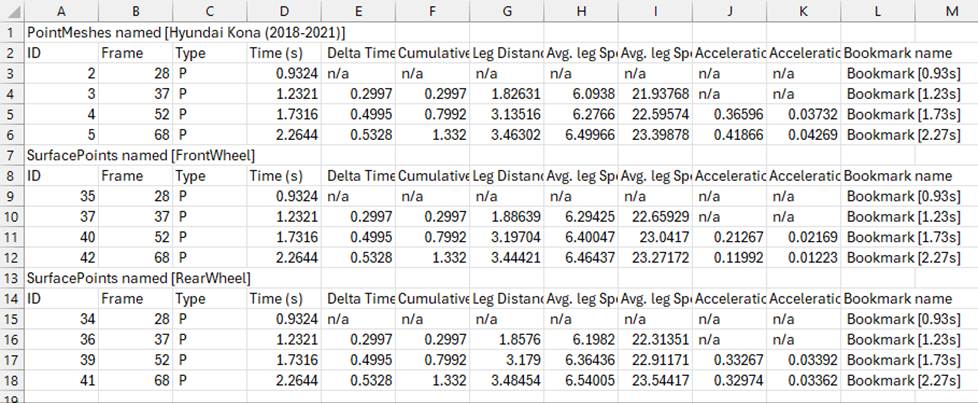

A CSV file with speed calculations can be generated. Speed is based on the timing from Video Bookmarks and the positions of objects (Surface Draw points and Pinned Point Clouds). The data is obtained from video bookmarks which can be created on videos or Image Sequences.
The distance between an object’s position at each time frame, and the time difference obtained from the bookmarks is used to compute the speed (units of speed based on the project units being metric or US). Multiple objects’ speeds can be computed. For an object’s speed to be computed, the object must have the same name at each bookmark time/layer. For Surface Draw points, use the Properties to name all the associated SD points the same name. For Pinned Point Clouds, the clouds will have the same name if the Secondary Copy method was used to create the subsequent clouds. Otherwise, the Point Cloud names can be set via Properties as well.
This report is generated from the Report button on the Video Bookmarks Pane. When the file has been written, the Video Report Summary appears.
Here is an example csv report file loaded in Excel:

Each object (a pinned point cloud, or named Surface Draw point) has its own section. That section starts with the name of the object. Then for each Video Bookmark there is a row with columns for the object ID number, which video frame, the frame type (P, I or B), the time of that frame and then columns that compute the speeds from distance and time differences. See the sections below for additional rows of the file that relate to filtering.
For projects with multiple videos, there is a column to indicate which video the Bookmark was tied to for easy reference. You can get times and speeds in one video, or even times and speeds across videos by naming the objects that are in those bookmarks across videos with the same names.
Dealing with Noise
There are different sources of ‘noise’ that can contribute to errors in speed estimation. PhotoModeler employs a couple of techniques to combat these.
See Encoded Timing Errors for how timing errors in the video can be compensated for by time averaging.
See Speed Noise Filtering on how to deal with the inherent noise that comes with computing speed from video (such as misplacement of points and pinned clouds).